The ambivalent idea of ‘them or us’ eloquently reflects some of the matters of concern that have occasionally propelled my past curatorial projects.
When asked for a contribution to an exhibition‘s catalogue of that same title, I proposed a walkthrough through some of those matters of concern.
Originally written in 2017, these arguments have since been lying dormant in another curator’s dream of a yet unpublished book.
Now, it felt urgent to spurt these stories out.
For one, because their timeliness may wane. There is a precise moment for everything, and our minds will certainly and hopefully fly away from our darkest considerations at one given moment. And for the other, because perhaps my own curatorial path has come to an interesting turning point.
After four blissful years at one of the most prestigious museum institutions in the world, and after another four schizophrenic years in Lisbon launching a museum at the intersection of contemporary art, architecture and the impacts of technology, it certainly feels like the sucked-out, turned-to-entertainment cultural arena is no longer the place from where one can address some of the matters of concern that affect our world today.
Perhaps writing is one good platform to address such matters of concern– and so perhaps I should again cherish this outdated blog format.
Or perhaps I should work harder on that plan to bring curatorial knowledge to those few cities and philanthropic institutions that have already come to realize they must redirect their resources in preparation for coming emergencies – but are still lacking the connections to the appropriate art and design intelligence.
For sure, in a society that has proclaimed itself capitalistic to death, one can also perhaps take in and accept Regine Debatty’s ironical intuition: we (must) make money, not art.
Maybe business and profit are indeed the ill-fated answer to emerging problems – as the words below may hint at.
As I land in Cambridge, Massachusetts, another blissful year immersed in the expansive intellectual environment of Harvard University will tell.
So, before everything becomes so last year, in this last Sunday* of our beloved month of August, here is my farewell gift to the country where I’ve spent the last four years.
I was seduced back to Portugal by that sort of sentimental appeal to which one eventually caves in for more personal and less obvious reasons.
These included the rare opportunity to launch a new institution, but also to provide your kin with a wider net of resources, including a few years of a (barely) still humanistic European education – i.e. giving your kids a second language in which they can properly express other ideas.
But now, it is time to leave again. Who knows if it is for good?
As expressed by a 17th century thinker that came to my mind during this last year of turmoil: “To be born, Portugal: to die, the world.” The son of a mulato woman, Padre António Vieira, travelled extensively around the world before he died in Brasil.
That is the Brasil that is now burning and was once the destination of a substantial part of Portuguese society, the aristocratic court included. Many Portuguese moved there, en masse and for good, two centuries ago. This became a quite unique, little known colonial history – a tale of ‘metropolitan reversal’ and substitution of a country by its colony, which is still to be unravelled and deconstructed in all its implications – especially for those left behind…
Meanwhile, today, in its desperate, ridiculous measures to lure emigrants back to Portugal, the current government may be realizing too late that one day in the near future this ever-after impoverished place will desperately need everybody that is still being systematically and viciously driven out of the country.
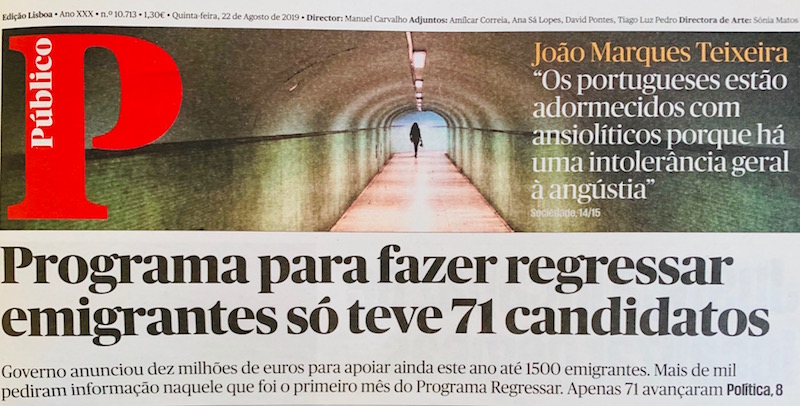 As announced on Público these days, a program of millions to bait emigrants back to the country, decoyed only 71 sentimental and ill-informed individuals.
As announced on Público these days, a program of millions to bait emigrants back to the country, decoyed only 71 sentimental and ill-informed individuals.
Madonna or Philip Stark may come and sing idiotic praise of Lisbon, but they will do only while they are bribed with 20% tax rates on their international royalties. Or until they quickly realize in what kind of bureaucratic nightmare they have landed – as Madonna did after only two years – and quickly promise to fly to the next fiscal paradise.
On the other opposite, what talented emigrant needs a 50% tax discount on incredibly low salaries? No ‘talent’ will be easily contented in a country in which the median salary is 950€ – but where a privileged, self-maintaining economic-political chaste diverts millions to offshores while a so-called leftist government coalition cracks down on the basic rights of the less affluent.
The logic of the local, nepotistic mafia, as I’ve heard it put by an insightful and exiled Portuguese researcher at Brown University circa 2012, is still basically the same: let them emigrants go eat cake somewhere else, so the less of us are left behind to fight for the remaining bread crumbs.
But if the day comes when all this exiled talent is needed, ties might be severed for too long for a comeback to be possible.
Think of the Portuguese names inscribed in the walls of the first synagogue ever established in New York, a few streets away from where I used to live in the Upper West Side. As Marx wisely put it, history first happens as tragedy, then as farce. Diaspora is diaspora.
So, in a mood of exorcism and cancellation, I offer you, and the world, a long weekend read: the previously unpublished and completely open-source English version of “Them or Us: Matters of Concern.” (Portuguese original essay here).
The Zombie Middle Class
In old John Carpenter movies, as again in the unstoppable awakening of the living dead in recent popular culture, one could already discern those allegories that evoke the indistinct and repellent forms to which the ‘others’ tend to be abridged, and ultimately turned into a ‘thing.’
Alas, when I was preparing the Uneven Growth exhibition at MoMA, in New York, it was the first time in my life in which I started to consider on which side of the fence I wanted – or could – situate myself in this dichotomy of ‘us’ and ‘the others.’
In a city and a country where class stratification is carefully obliterated from any debate – but where economic inequality is as expressive as in a regime of apartheid – we are inescapably driven to reflect on a daily basis about the pole where we might find ourselves, or where we aspire to be within a dual social scheme.
In Europe, while economic stress does not spread from South to North, one still endures peacefully with the imprecise comfort of a middle class generated by the post-War Welfare State.
In the United States, and in a city like New York, the idea of the social elevator associated to the American Dream has long been broken, reduced as it is now to a random social lottery. This is the place where we seriously start to consider if we may be contented with a falsely idealized ‘us’.
 Image from Business Insider: The Global Middle Class is in a State of Decay
Image from Business Insider: The Global Middle Class is in a State of Decay
With the rattle of a middle-class increasingly squeezed between opposites, we discover a socio-economical niche slowly compelled to choose if they adhere by all possible means to the top 1%, or if, without true choice, they let themselves slid into deprivation.
Even if ideologically or culturally one does not want to embrace the 1% – and thus contribute to a growing asymmetry – who in their perfect mind would choose the second option?
I’d Rather Not
Although ultimately everything may depend on the difficult art of maintaining all options open, the ‘us’ of an urban(e) middle class in risk of extinction will eventually have to choose between the two ‘others’ that increasingly and radically polarize in globalized cities.
It is certainly not per chance that the biggest growing ‘urban typologies’ in recent years are ‘gated communities’ and… the slums.
The ‘choice’ between these two –or the rising loss of such mirage– is what pervades a metropolis such as Rio de Janeiro, one of the megacities examined and portrayed in Uneven Growth.
 Uneven Growth’s blog, with tactical urbanism contributions from around the globe.
Uneven Growth’s blog, with tactical urbanism contributions from around the globe.
As in other metropolises of Asia or Africa for which we’ve harnessed some top critical thinking, the social strata that corresponds to a lower, worthy middle class –comprised of qualified workers and services employees– is now bound to inhabit the city in ‘informal conditions.’ This is the only regime that ‘favelados’, or those condemned to the slums, manage with their meagre earnings.
One should always correctly underline that, globally, millions are escaping extreme poverty. But what is usually and conveniently forgotten, is that such an escape does not necessarily translate into a palpable and dignified access to the ‘formal city’ that fits with the Western definition of middle-class.
More alarming is the fact that, given the evolution of the planet’s ecological crisis and the gradual depletion of its resources, we should not expect this tendency to reverse. On the contrary, it is not difficult to predict that this tendency will rather spread to contexts where until now prevailed the formal regime of a broadly established middle-class.
One should only remember the cautionary tale of Detroit, once the capital of the American auto industry. Or be reminded of how, in the wake of the Katrina storm, New Orleans made evident that urban ferality – or the potential of a city to regress into chaos and a previous evolutionary stage – is always lurking closer than one imagines.
As in other subjects, the research of American military intelligence has already long ago registered these facts with a cold, calculating, sort of mild anxiety.
A Lapse in History
When we remember that, in Europe or in cities such as New York, substantial parts of the urban population only gained access to a ‘rightful’ city in the beginnings of the 20thcentury, we realize how the ‘us’ of the middle-class as we know it today can one day be studied as an ephemeral reality, a brief and exotic instant in the long history of humanity.
As we have discussed throughout Uneven Growth, the slum eradication programs in big European and American cities were sustained by rapid industrial growth – as well as, let’s face it, by the wealth resulting from colonization and the increasing devastation of fossil fuels and the extraction of other natural resources.
Today, however, we will hardly have the resources to control and counter the expansion of new, fast-spreading informal urban developments. The tactical urbanisms addressed in the MoMA exhibition predicted bottom-up solutions for adaptation, more than an impossible eradication.
In this context, it is not hard to anticipate scenarios that align with much science fiction recently produced in Hollywood –from Elysium to Ghost in the Shell– in which informal regimes, radical inequality and generalized poverty fuse and hybridize with advanced, mass-produced technologies.
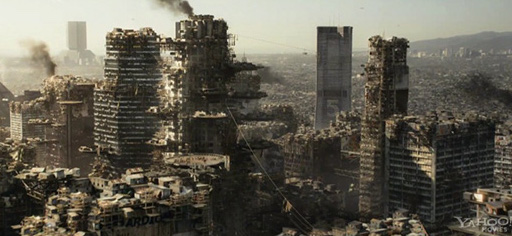 The global slum in Neil Blomkamp’s Elysium. Image from solidarity-us.org.
The global slum in Neil Blomkamp’s Elysium. Image from solidarity-us.org.
This is the everyday steampunk that has been portrayed by the likes of Margaret Atwood or Bruce Sterling, but was first glimpsed at the level of popular culture in films such as Ridley Scott’s Blade Runner.
Now, after movies have made it distortedly glamorous, it really is the time to welcome the technologically-enhanced slum.
Rat Tribes and Other Contemporary Humans
The more dystopian scenarios facing humanity in the near future – as opposed to the 500-year dream of utopia that brought us to the present – was the theme of the Utopia/Dystopia book, as well as MAAT’s first manifesto exhibition reuniting artists and architects.
Given the sudden turn from utopia to dystopia, it is unsurprising that so many artists today look at the decline of basic human rights in different contexts, often related to the growth of urban informality in an age of ecological distress.
The informal is back, also as an aesthetic pursuit.
And amid the broad return to a plastic and visual informality, some artists focus particularly on emerging hidden social realities so as to make them visible to the general public.
During the 15thIstanbul Biennale, led by artist duo Elmgreen & Dragset under the theme A Good Neighbor, some 10% of the 56 invited artists decided to work on the emergence of new, dismal realities of the urban informal habitat.
Originating in different geographical contexts, a few artworks portrayed individuals that some years ago would be happy to be born in societies where slum living had been or was being abolished.
In The Fascism of Daily Life, British artists Morag Keil and Georgie Nettell reveal the degrading shared-housing conditions of young London professionals who, in the heart of Europe’s financial capital, confront the harsh reality of being the first European generation that on average earns less than their parents.
Chinese artist Sim Chi Yin, on the other hand, discloses the tight, unhealthy subterranean dwellings of what Chinese media call the ‘rat tribe’: youngsters who are forced to live in dire conditions to guarantee proximity to their jobs in downtown Beijing.

Image from The Rat Tribe series, circa 2012, courtesy Sim Chi Yin.
During the research for Uneven Growth, similar situations of ‘invisibility’ were found in the neighborhoods of Queens, New York, where incoming immigrants share slum-dormitories by the dozens, in anonymous converted terrace houses.
The difference regarding the past is that the new tribes own smartphones and, beyond their unavoidable fiscal contributions, they willingly play their share in the system of consumption that drives the global economy towards its logical disaster.
As a member of the public wittingly responded to one of the proposals in Uneven Growth, “if you can’t give them bread, give them wifi.”
Them or Us
Even in a periphery such as Portugal, the notion of ‘us’ is progressively identifiable –to the extremes of political correcteness and its opposites– with those who have a certain economic or social power, who have come to achieve a certain level of knowledge, those who ‘understand the world’ (including understanding ‘the other’), those who have supposedly deconstructed and overcome their colonial symptoms.
The ‘us’ is also identifiable with those those who still proudly self-classify as middle class, and those who, well, are convinced that they are definitely beyond the evolutionary stage of slum living.
The ‘them’, on the other hand, encompasses all those who are not framed within such diffuse ontological categories.
These include the usual migrants and refugees, the indigenous, those of ‘other races,’ the ‘poor’, but also those who came before us, those who don’t agree with us, those who in one form or another dominate us, and also all the non-humans who, in a forthright Anthropocene age, seem to have suddenly ‘reappeared’ to share the planet.
And it is true that the ‘or’ that sits in-between these two interchangeable realities has a character of radical exclusion, which again and moreover comes down to a Darwinian survival instinct.
If, anthropologically, this instinct has always been present – the survival of ‘our’ group depends on the annihilation of the ‘other’ group – such impulse accrues whenever a generic menace pops up.
If racial and ethnic differences serve to spark the conflict, factors such as the scarcity of resources, not to say the endemic poverty of a region or a nation, as well as the yet only barely perceived effects of climate change, are some of the threats that sharpen the mutually exclusive character of the ‘or’ that sits between ‘them’ and ‘us.’
In the midst of this terse dichotomy, full of inevitable belligerent contours, it is convenient to be reminded that ‘we’ are always the ‘they’ of another ‘other.’
In Southern Europe, as we well know, we are the ‘them’ of Northern Europeans. And vice-versa. In the streets of Luanda, I occasionally felt an entrenched racism penetrating the surface of my phantom-white skin, as I’m sure that all Angolans who do not resemble affluent oligarchs have occasionally had the same exact feeling in the streets of Lisbon.
As another curatorial project came to investigate, one of the less discussed impacts of the climate crisis is precisely the radical increment of socio-economic inequalities.
The investigation for the Eco-Visionaries exhibition and book may well have started with the idea of combining ‘the pessimism of the intellect’ with ‘the optimism of will.’ But, early on, the latter was easily submerged in the former.
After all, it is necessary to state that, contrary to how the news of the day non-challantly put it, the growth of global inequity will not so much occur because the ‘poor’ countries who less contribute to climate change will be the first ones to be affected.
Even in a country undergoing severe drought and increasing desertification, such as Portugal, this is the kind of factoid that seems to have little effect on ‘us.’
We conveniently assume that this new imbalance affects only some distant ‘them’ – a few small island-nations that will sink into oblivion, or, on the other side of the scale, a few African countries whose populations are beginning to fall prey to hunger and thirst.
No.
What is seldom discussed –and only a few dare to suggest in writing, most notably Bruno Latour in ‘Down to Earth’– is that the slow evidence of a 6thMass Extinction on planet Earth will trigger first famines and war, and then a technological rat race to determine who are the 66 to 97 or 99% of the human population (have your guess) that will face extermination, so that any number from the ‘other’ third to 1 or 3% will comfortably join the new Noah’s Ark.
In preparation to such an event, these cold probabilities imply, first of all, that inequalities must be accentuated beyond recognition, as governments around the world seem to have already quietly assumed.
And secondly, one must actively and furiously create the biggest number possible of ‘others’ that are destined to be erased, so as to start fast reducing the numbers of those who will be able to integrate the privileged group of the surviving ‘us.’
The ease with which, as I write, Donald Trump announced at the United Nations –to no visible indignation– that he was more than ready to eradicate 25 million North-Koreans is, of course, only a bitter aperitif to the coming decades.
If those 25 million humans are merely guilty of the unfortunate fate of living in a mad dictatorship, the less affluent in the United States should start to shiver.
 An Instagram view of Eco-Visionaries at Madrid’s Matadero.
An Instagram view of Eco-Visionaries at Madrid’s Matadero.
The New Normal
The probable event that scientists designate as the 6th Mass Extinction, is nothing else than the logic and objective corollary of a thorough analysis of five previous such events. As research shows, along the history of our planet these events have led to the disappearance of most species then existing.
We humans are left with the doubtful comfort that our ancestors were one of the species that survived the 5thMass Extinction. But we may also cheer with mixed joy that, given the current status of our technology, we may be one of the few species that will also survive the next extinction event.
Even if we are not guided by principles of divine justice, we may lament everything that is already disappearing. (What was that piece of news that seemed so impactful the first time we read it? Ah, yes, finally it is only one million species that are facing extinction. Phew!)
We may also furtively commemorate that there is a strong and perverse possibility that we survive that ugly moment in which the planet will naturally regurgitate and vomit all the garbage that we have produced since the advent of the Industrial Revolution.
Meanwhile, out of the pure need to maintain our mental balance, we will adamantly ignore and repress this seemingly unstoppable progression towards planetary readjustment.
In fact, this extinction phenomenon may occur anytime between 50 to 250 years ahead, according to the degree of optimismof each potential scenario.
As such, ‘we’ may, once again, take comfort from the probability that we will no longer see the worst – even if, with this psychological resource, we are actually (and indifferently) putting our sons and grandsons in the despicable category of ‘them.’
Put in other terms, the emotional readjustment to what is coming will necessarily translate in a need to adapt the human perceptive system to a ‘new normal.’
And this is a ‘new normal’ which is pretty more radical that the one that still inflates the discourses of politicians and economists.
This is not the ‘new normal’ of the economy’s secular stagnation after the great recession of 2008. And this is not the new normal of slowbalization.
This is not even the ‘new normal’ of the rebirth of nationalist and populist base instincts. This is the ‘new normal’ of the long, bumpy road to a potential total annihilation.
And, in this respect, contemporary art and culture may hopefully still have a role that goes beyond a necessary political activism – as I’ve once suggested to the architectural field in MoMA’s exhibition Ways of Being Political.
It may have a role that goes beyond the occasional unveiling of what remains invisible in today’s society, as put to evidence in the video works shown in MAAT’s exhibition Tension & Conflict.
 Jorge Macchi’s 12 Short Songs, at MAAT’s Tension&Conflict, Video Art After 2008.
Jorge Macchi’s 12 Short Songs, at MAAT’s Tension&Conflict, Video Art After 2008.
J.W. Turner and the Impressionists have helped us get acquainted to a new industrial era, and transformed atmospheric pollution in a new motif for the Kantian sublime – a notion that, let’s recall it, was itself triggered by the idea of catastrophe, and in particular by the lasting echoes of the Lisbon 1755 earthquake on the thinkers of the Enlightenment.
Futurists and Cubists, on the other hand, helped us getting used to the modern distortions of visuality and culture, ignited by the rise of new technologies that both fed the vertigo of speed or the complexification of urban life, as well as the massacres of World War I.
In face of the new normal’s most superficial signs, many in today’s art field find immediate consolation in the humble idea of ‘resistance.’ In a polarity that since the heights of Modernity is already traditional in cultural production, the illusory attraction of ‘resistance’ orients art towards autonomy, but also more dangerously to an effective refusal to take the bull by the horns.
Yet, while the uselessness of art, usually hiding in such arguments, may still be considered a silly advantage, such uselessness may effectively come to assert art to its own inconsequential mass extinction.
Indeed, in face of the new normal’s deeper character, what would be the advantage of art’s uselessness? Temporary comfort while one sinks? Food for thought while one starves? Or is it just a market strategy to guarantee the symbolic values of an increasing inequality while we fight for the last resources?
On the contrary, I still want to believe that art can again assume the role of an avant-garde in dissecting a yet poorly understood global war. I still want to believe that cultural production, as cultural mediation, will still have a role in that opposition of ‘them’ or ‘us’ that ultimately is the quintessence of the ‘new normal.’
The ‘new normal’ – the expression we now use to express resignation to an era in which nothing will be as before, or as Naomi Klein put it, to a condition that ‘changes everything’ – is surely a good theme for a future curatorial endeavor, wherever that may happen.
I do believe that, vis-à-vis ‘our’ and ‘their’ long path of psychological adjustment to the ‘new normal,’ artistic practices in any cultural field – think of Darren Aronofski’s Mother – are once again called upon to make us cope with the inevitability of living on an everyday basis with the new paradigms of the unequal, the informal, the ugly, and the monstrous.
This text was commissioned for the yet unpublished catalogue of “Them or Us: um Projecto de Ficção Científica, Social e Política”, an exhibition curated by Paulo Mendes at Porto’s Municipal Gallery, from June 2 to August 13, 2017.
*Here you find the soundtrack for this post.
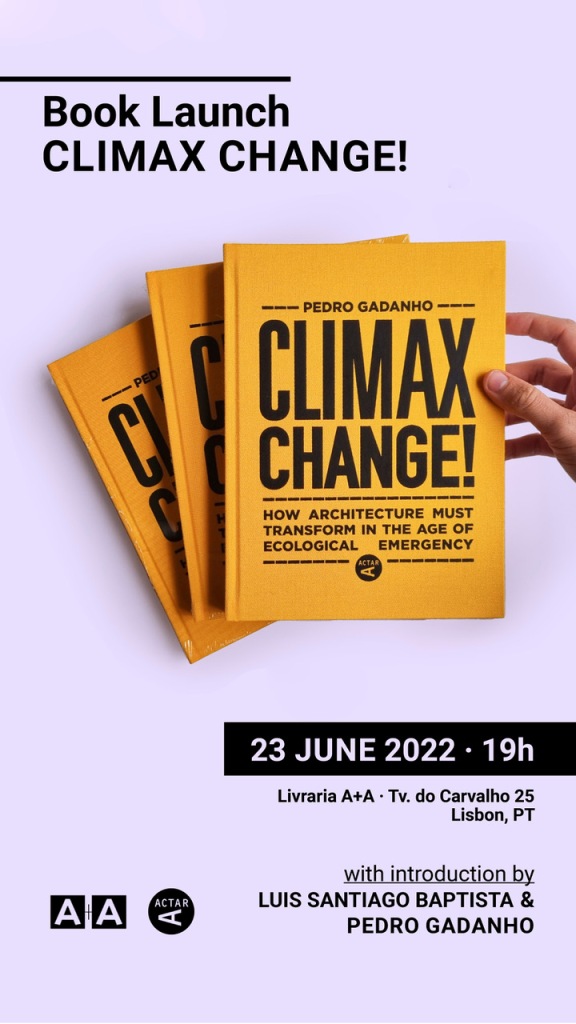

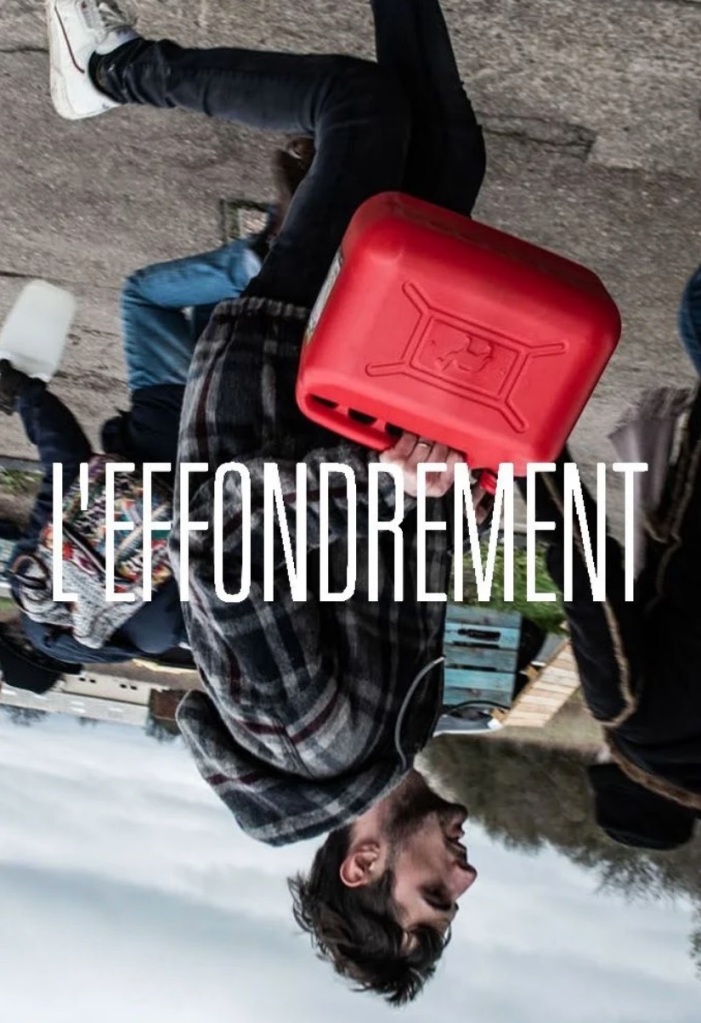


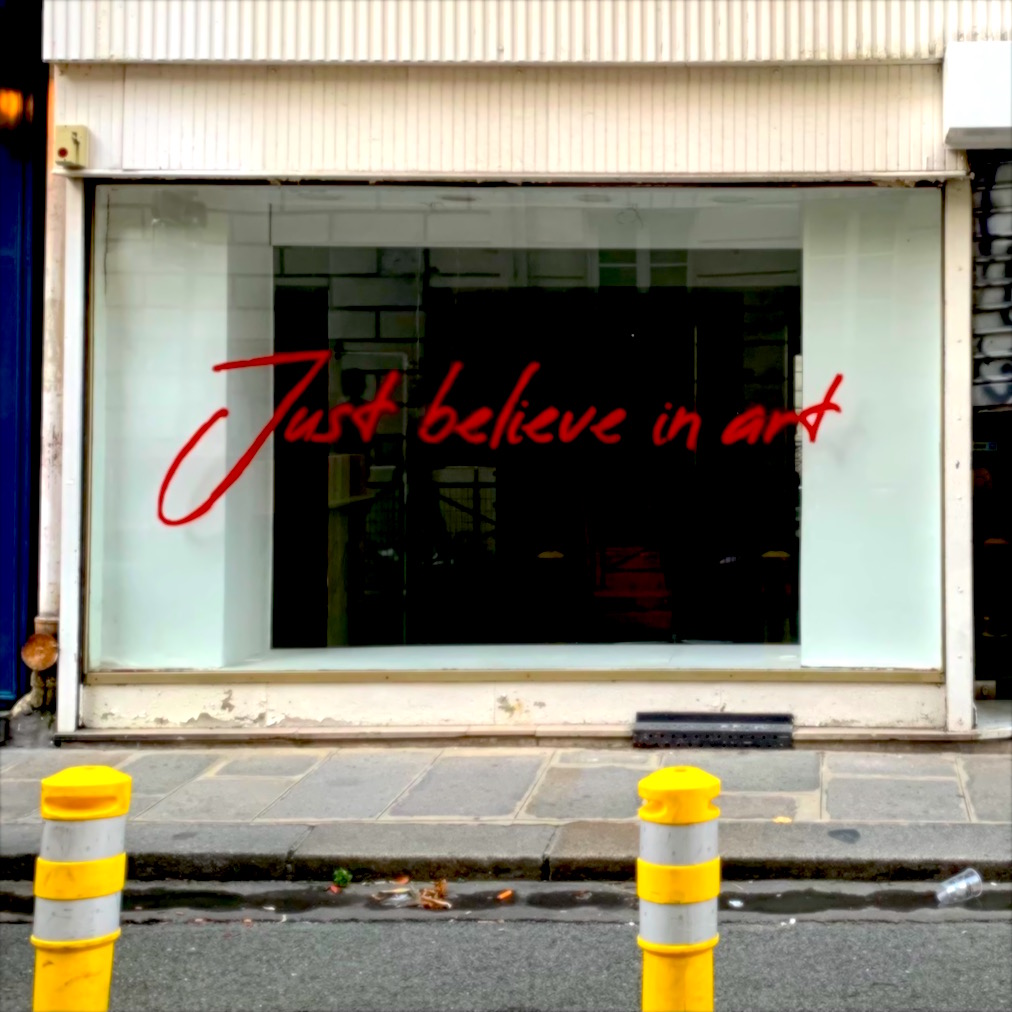
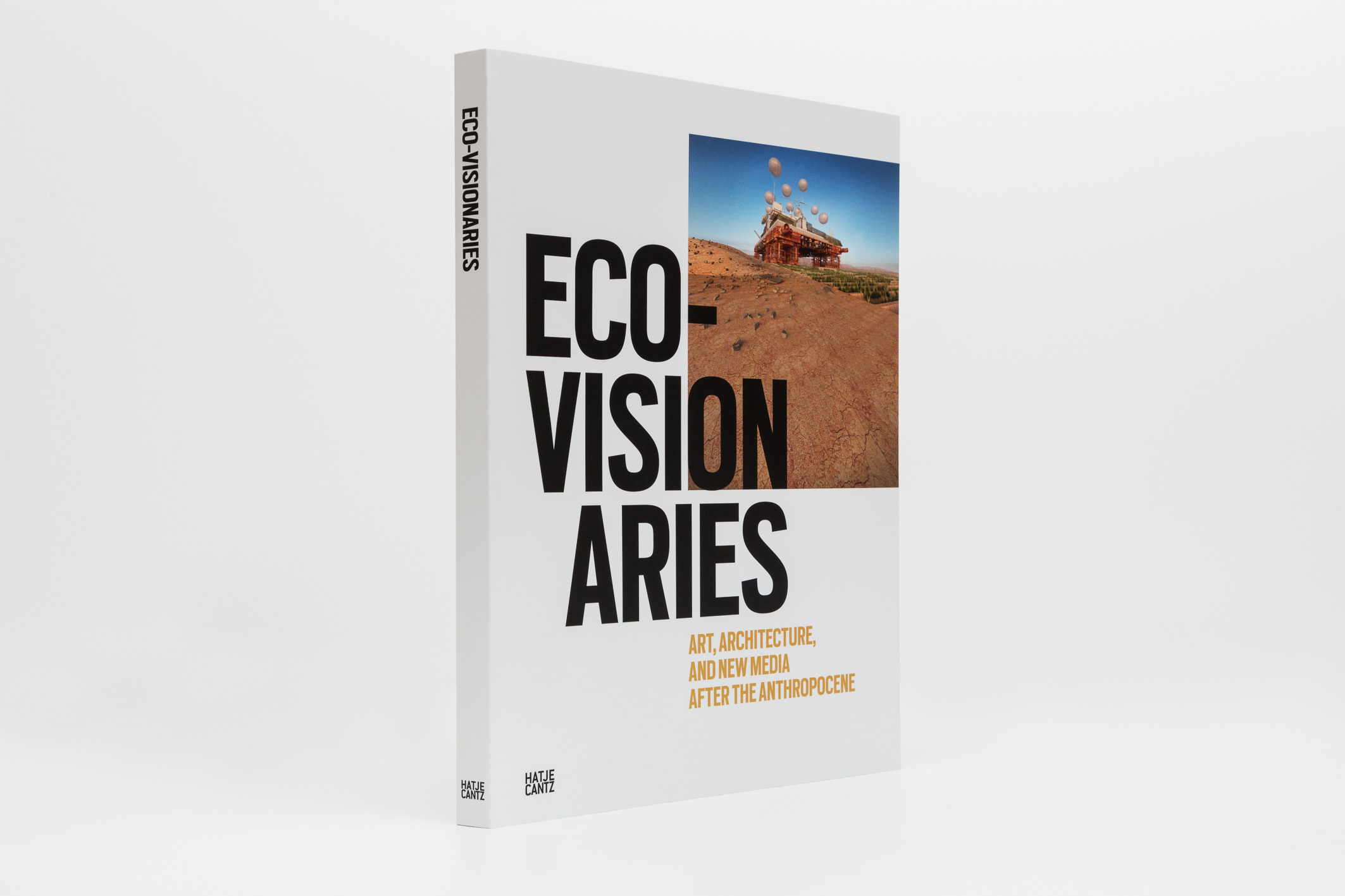 At least, the Eco-Visionaries book still features in must-read lists, such as
At least, the Eco-Visionaries book still features in must-read lists, such as 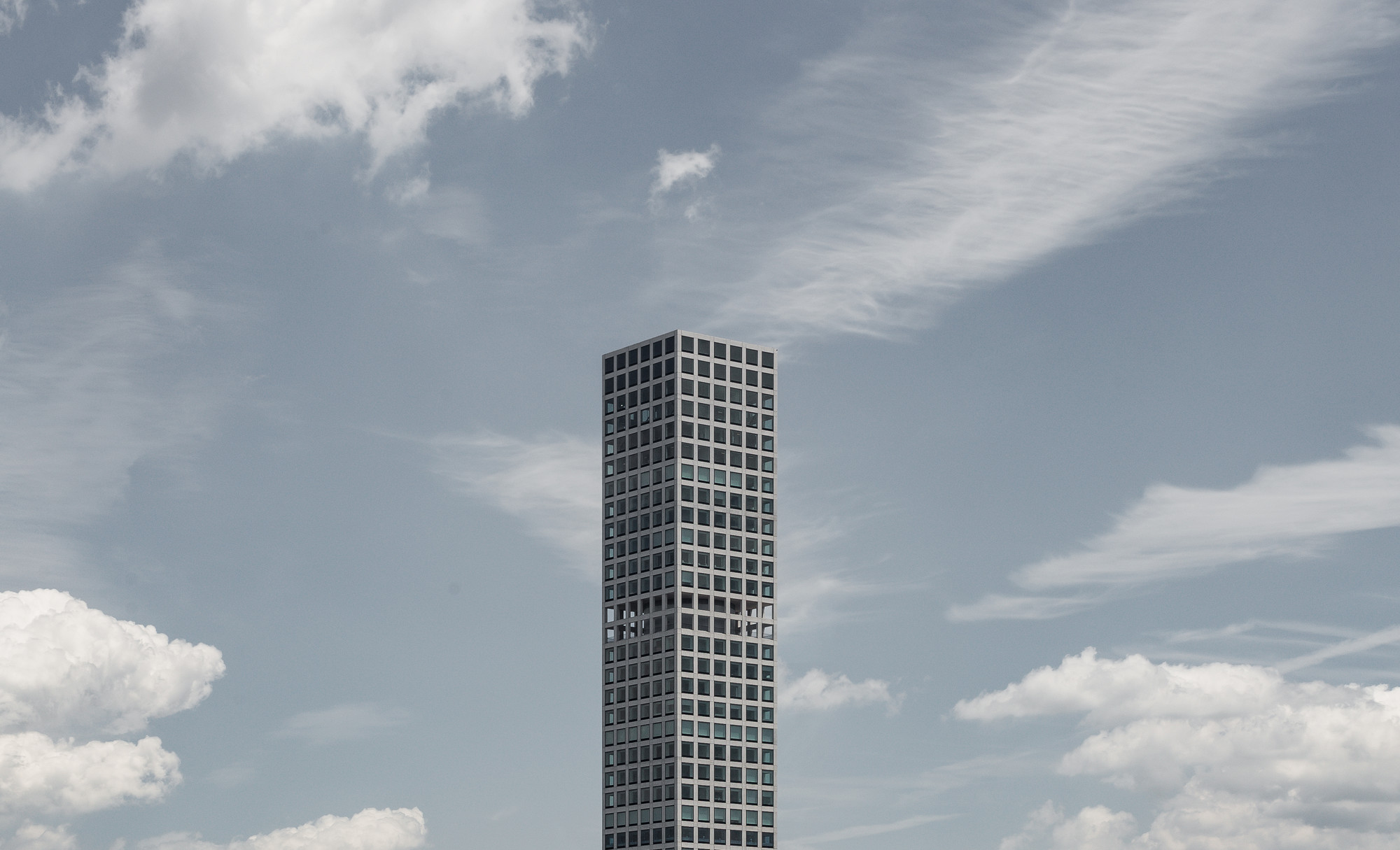
 As announced on Público these days, a program of millions to bait emigrants back to the country, decoyed only 71 sentimental and ill-informed individuals.
As announced on Público these days, a program of millions to bait emigrants back to the country, decoyed only 71 sentimental and ill-informed individuals. Image from
Image from 
 The global slum in Neil Blomkamp’s
The global slum in Neil Blomkamp’s 

 Jorge Macchi’s 12 Short Songs, at MAAT’s
Jorge Macchi’s 12 Short Songs, at MAAT’s 
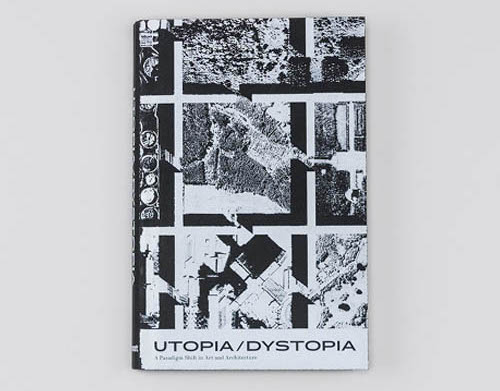
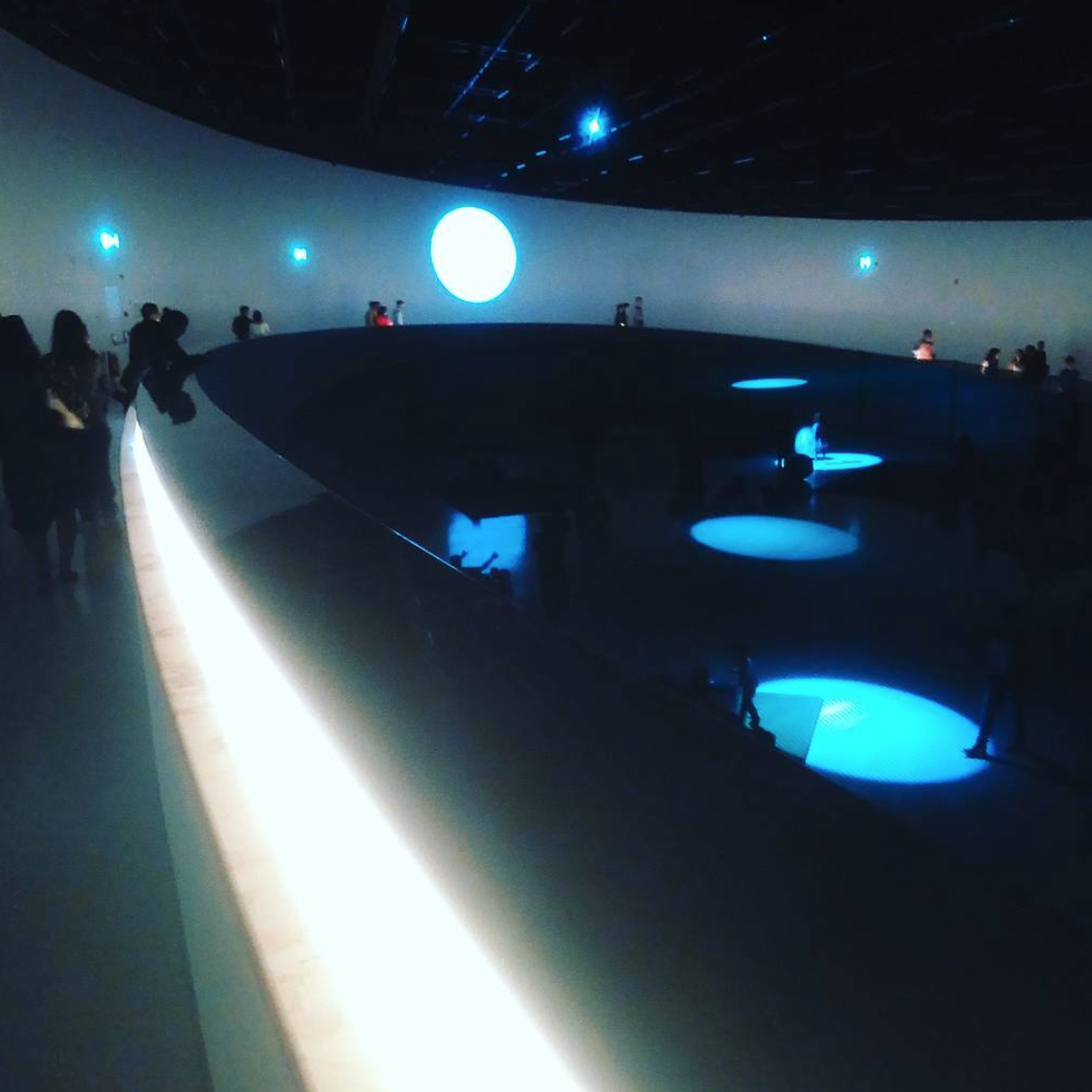
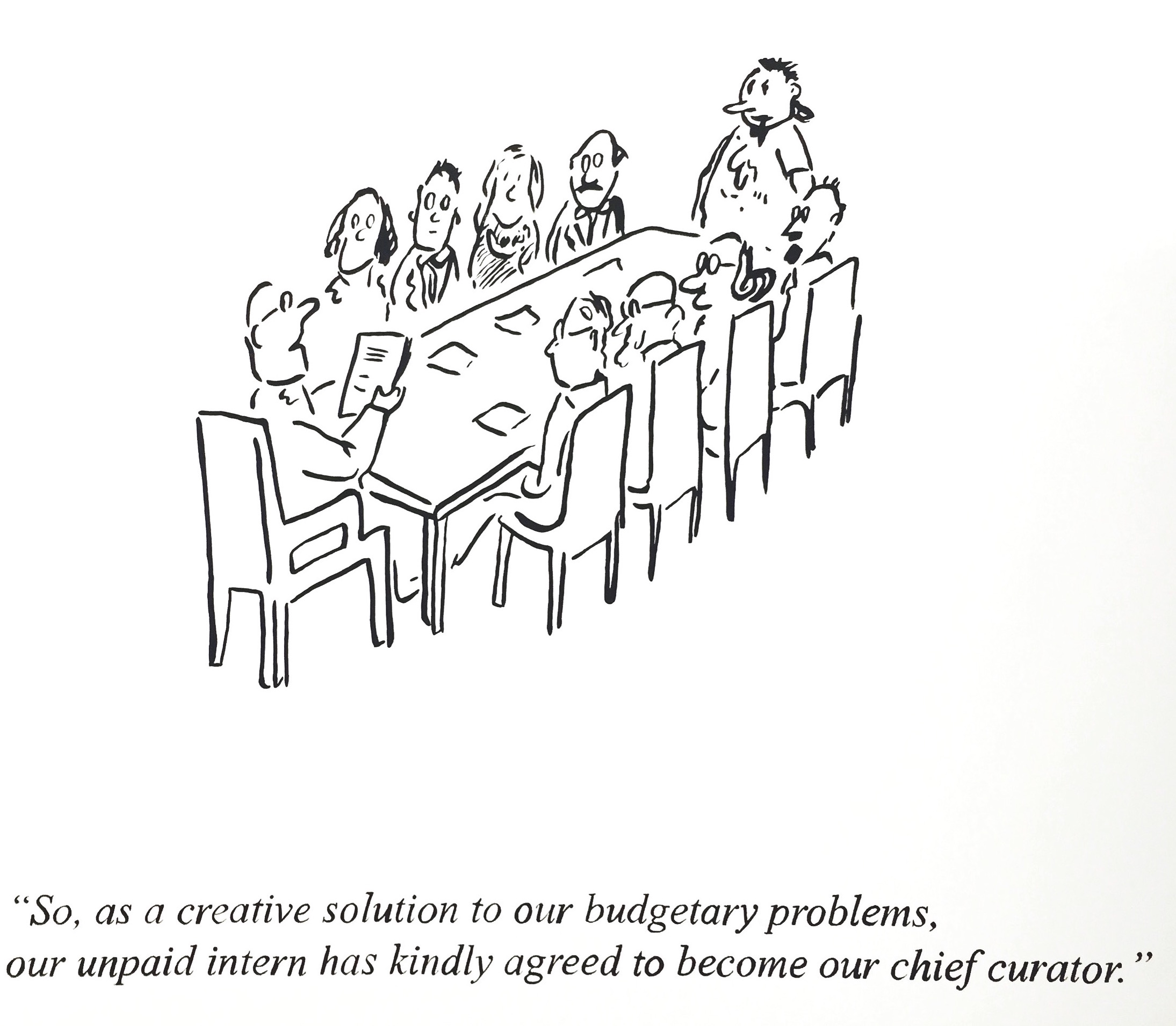 Artwork by my colleague at MoMA,
Artwork by my colleague at MoMA, 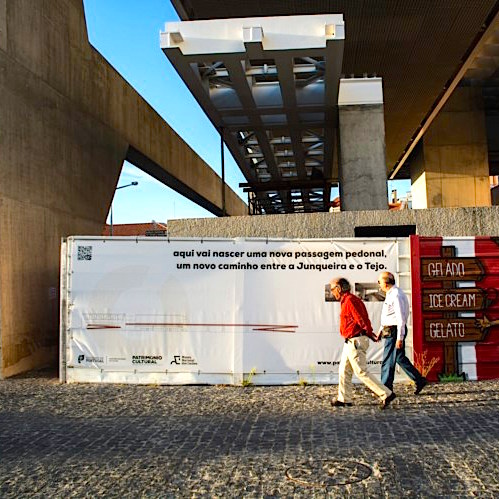
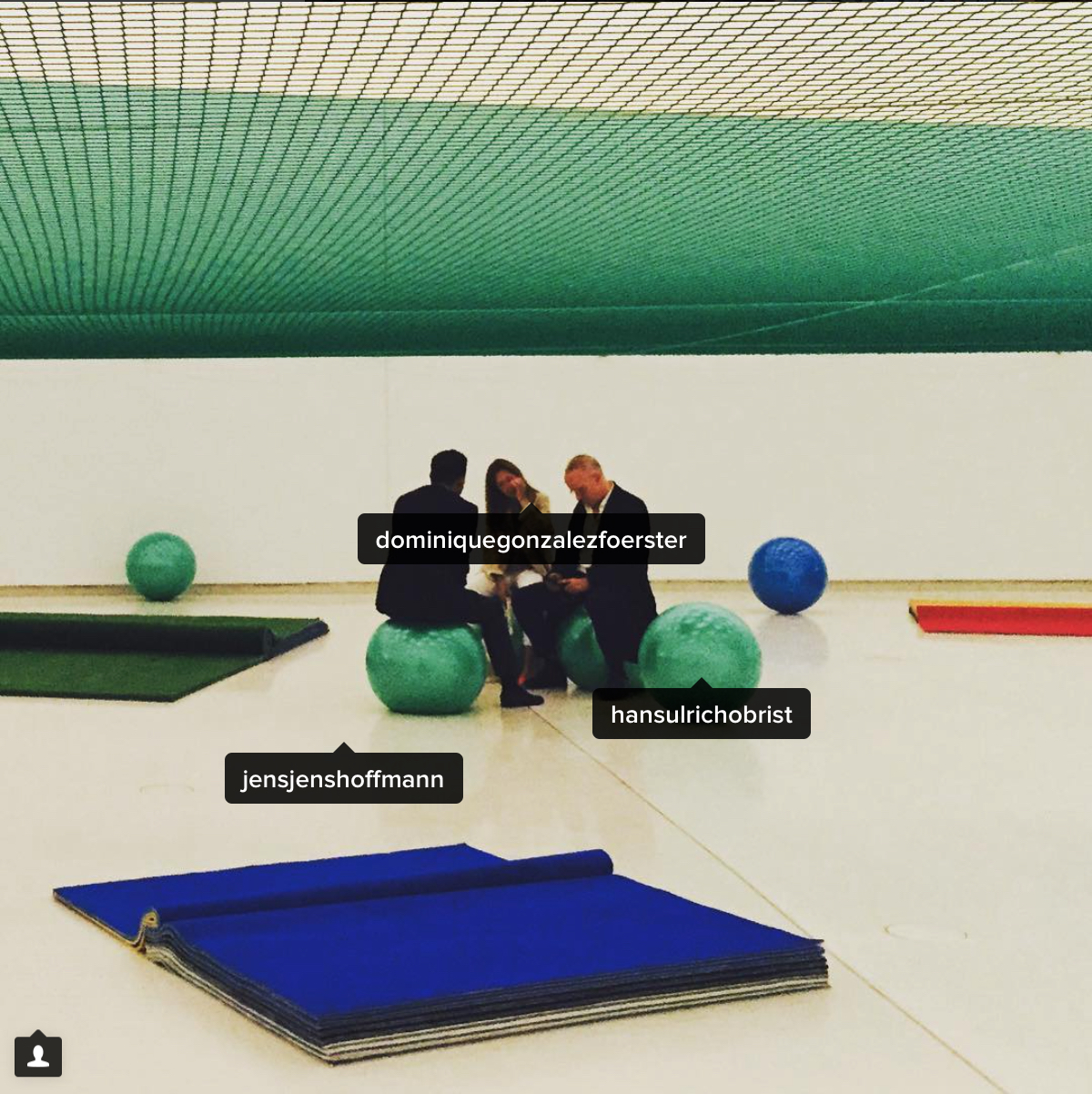

 Zaha Hadid, fotografada por Steve Double, via
Zaha Hadid, fotografada por Steve Double, via 
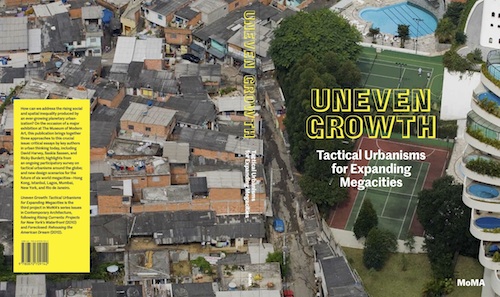 Sneak-preview de
Sneak-preview de 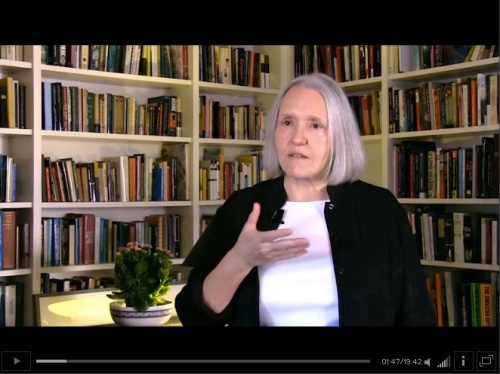
 Image hacked from
Image hacked from  Wall-E hacked from
Wall-E hacked from 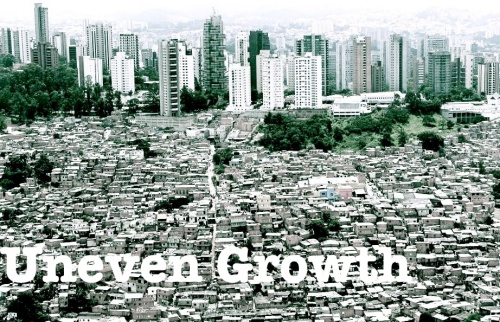
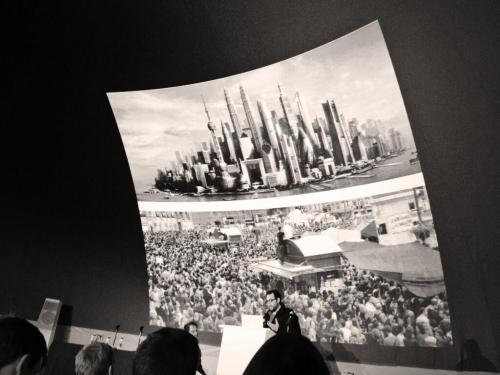
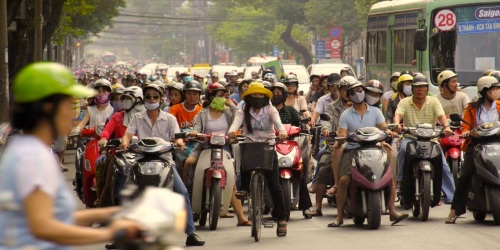 As ruas de Saigão, a.k.a. Ho Chi Min City, via
As ruas de Saigão, a.k.a. Ho Chi Min City, via